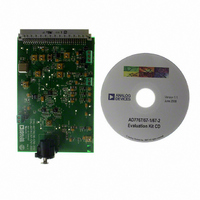EVAL-AD7767-1EDZ Analog Devices Inc, EVAL-AD7767-1EDZ Datasheet - Page 17

EVAL-AD7767-1EDZ
Manufacturer Part Number
EVAL-AD7767-1EDZ
Description
BOARD EVAL AD7767-1 64KSPS 111DB
Manufacturer
Analog Devices Inc
Specifications of EVAL-AD7767-1EDZ
Number Of Adc's
1
Number Of Bits
24
Sampling Rate (per Second)
64k
Data Interface
Serial
Inputs Per Adc
1 Differential
Input Range
±VREF
Power (typ) @ Conditions
10.5mW @ 64kSPS
Voltage Supply Source
Analog and Digital
Operating Temperature
-40°C ~ 105°C
Utilized Ic / Part
AD7767-1
Lead Free Status / RoHS Status
Lead free / RoHS Compliant
AD7767 INTERFACE
The AD7767 provides the user with a flexible serial interface,
enabling the user to implement the most desirable interfacing
scheme for their application. The AD7767 interface comprises
seven different signals. Five of these signals are inputs: MCLK,
CS , SYNC / PD , SCLK, and SDI. The other two signals are
outputs: DRDY and SDO.
INITIAL POWER-UP
On initial power-up, apply a continuous MCLK signal. It is
recommended that the user reset the AD7767 to clear the filters
and ensure correct operation. The reset is completed as shown
in Figure 5, with all events occurring relative to the rising edge
of MCLK. A negative pulse on the SYNC / PD input initiates the
reset, and the DRDY output switches to logic high and remains
high until valid data is available. Following the power-up of the
AD7767 by transitioning the SYNC / PD pin to logic high, a settling
time is required before valid data is output by the device. This
settling time, t
the decimation rate.
model and should be referenced when reviewing
Table 7. Filter Settling Time After SYNC / PD
Model
AD7767
AD7767-1
AD7767-2
1
READING DATA
The AD7767 outputs its data conversion results in an MSB-first,
twos complement, 24-bit format on the serial data output pin
(SDO). MCLK is the master clock, which controls all the AD7767
conversions. The SCLK is the serial clock input for the device.
All data transfers take place with respect to the SCLK signal.
The DRDY line is used as a status signal to indicate when the
data is available to be read from the AD7767. The falling edge of
DRDY indicates that a new data-word is available in the output
register of the device. DRDY stays low during the period that
output data is permitted to be read from the SDO pin. The
DRDY signal returns to logic high to indicate when not to read
from the device. Ensure that a data read is not attempted during
this period while the output register is being updated.
t
to the falling edge of DRDY .
SETTLING
is measured from the first MCLK rising edge after the rising edge of SYNC / PD
SETTLING
Decimation Rate
8
16
32
Table 7
, is a function of the MCLK frequency and
lists the settling time of each AD7767
t
(594 × t
(1186 × t
(2370 × t
SETTLING
1
MCLK
MCLK
MCLK
Figure 5
) + t
) + t
) + t
21
21
21
.
Rev. C | Page 17 of 24
The AD7767 offers the option of using a chip select input signal
( CS ) in its data read cycle. The CS signal is a gate for the SDO pin
and allows many AD7767 devices to share the same serial bus. It
acts as an instruction signal to each of these devices indicating
permission to use the bus. When CS is logic high, the SDO line
of the AD7767 is tristated.
There are two distinct patterns that can be initiated to read data
from the AD7767 device: a pattern for when the CS falling edge
occurs after the DRDY falling edge and a pattern for when the
CS falling edge occurs before the DRDY falling edge (when CS
is set to logic low).
When the CS falling edge occurs after the DRDY falling edge,
the MSB of the conversion result is available on the SDO line on
the CS falling edge. The remaining bits of the conversion result
(MSB − 1, MSB − 2, and so on) are clocked onto the SDO line
by the falling edges of SCLK that follow the CS falling edge.
Figure 3
When CS is tied low, the AD7767 serial interface can operate in
3-wire mode as shown in
conversion result is available on the SDO line on the falling
edge of
(MSB − 1, MSB − 2, and so on) are clocked onto the SDO line
by the subsequent SCLK falling edges.
POWER-DOWN, RESET, AND SYNCHRONIZATION
The AD7767 SYNC / PD pin allows the user to synchronize
multiple AD7767 devices. This pin also allows the user to reset
and power down the AD7767 device. These features are
implemented relative to the rising edges of MCLK and are
shown in
To power down, reset, or synchronize a device, the AD7767
SYNC / PD pin should be taken low. On the first rising edge of
MCLK, the AD7767 is powered down. The DRDY pin transi-
tions to logic high, indicating that the data in the output register
is no longer valid. The status of the SYNC / PD pin is checked on
each subsequent rising edge of MCLK. On the first rising edge
of MCLK after the SYNC / PD pin is taken high, the AD7767 is
taken out of power-down. On the next rising edge, the filter of
the AD7767 is reset. On the following rising edge, the first new
sample is taken.
A settling time, t
valid data is output by the device (see Table 7). The DRDY
output goes logic low after t
available on SDO for readback.
DRDY . The remaining bits of the data conversion result
details this interfacing scheme.
Figure 5
SETTLING
, marked as A, B, C, and D.
, from the filter reset must elapse before
Figure 4
SETTLING
. In this case, the MSB of the
to indicate when valid data is
AD7767


















